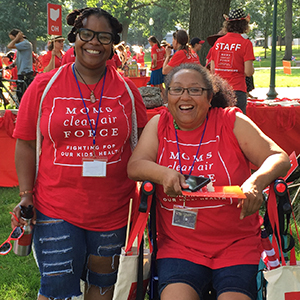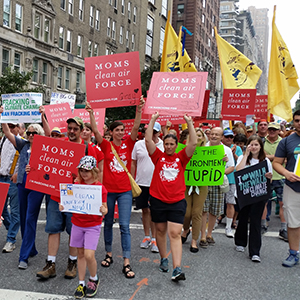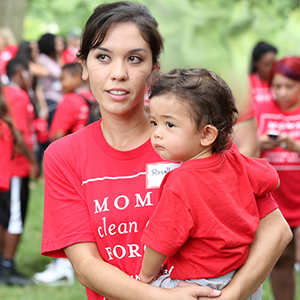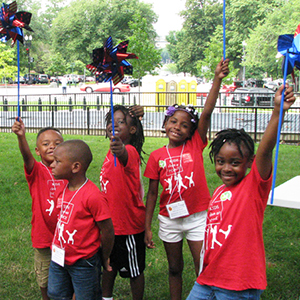This resource has been factchecked by policy experts, using the latest scientific research. It was written in partnership with the American Academy of Allergy, Asthma & Immunology.
From the prenatal months to the critical developmental years of adolescence and early adulthood, children and young people are vulnerable to the impacts of a warming world. Extreme heat, wildfire smoke, stronger storms, and other climate threats interact with children’s health in unique ways. This is happening right now, not in some distant, imagined future. Protecting our kids’ well-being and building a better future for younger generations is paramount.

Specific health impacts of climate change on children
Children’s still-developing bodies, behavioral patterns, and social environments make them particularly vulnerable to climate threats. Here are some of the ways children’s and young people’s health is currently directly endangered by the climate crisis:
Extreme heat
When temperatures climb, children’s bodies can’t regulate heat as well as adult bodies, putting them at higher risk for heat-related illnesses like dehydration, heat exhaustion, and even life-threatening heat stroke. High temperatures can have prenatal impact too and have been linked to stillbirth, premature birth, and low birth weight.
Air pollution
The burning of fossil fuels for energy—the primary driver of the climate crisis—generates toxic pollution that’s especially unhealthy for babies and children. Climate change is making wildfire season longer and more intense, and wildfire smoke may be even more dangerous than other types of air pollution. Breathing unhealthy air can interfere with lung development and is linked to health harms like asthma, respiratory illness, low birth weight, and premature birth.

Changing pollen seasons
Climate change is lengthening and worsening the severity of pollen seasons, exacerbating allergies like hay fever and asthma attacks.
Diseases spread by insects
A heated world is a hospitable environment for a range of insects and their diseases: mosquitoes and West Nile, ticks and Lyme, and more. Children aged 5–9 are among the most likely groups to contract Lyme disease, which is steadily on the rise in the US.
Extreme weather and food insecurity
Climate change is increasing the frequency and intensity of conditions that make it harder for farmers to grow healthy crops, like droughts and flood events. This can lead to food insecurity and malnutrition, which are especially harmful for babies’ and children’s development.
Storms and flooding
Climate change is increasing the intensity of storms. Strong storms, like hurricanes, tornadoes, and even extreme rain, can damage homes and flood communities, increasing risk of injury and forcing families to evacuate. Coastal flooding and sea-level rise also threaten to displace hundreds of thousands of children and young people in coastal areas in the coming decades. Plus, when drainage and sewage systems are overwhelmed by floodwaters, drinking water can easily be contaminated, increasing potential for exposure to waterborne illnesses, chemical runoff, and hazardous waste. Mold resulting from damp conditions can cause serious health issues, including skin rashes, asthma, and infections.

Environmental justice, climate impact, and young people’s health
Climate change is a threat multiplier that amplifies existing inequities.
For example, Black and Brown communities are more likely to be sited in urban heat islands that lack adequate green space or shade, increasing the dangers of extreme heat and making it harder for children to play safely outside. In low-income communities where schools lack air conditioning, high temperatures can lead to learning losses at school.
When climate disasters like flooding and hurricanes strike, communities of color are less likely to receive federal aid to rebuild damaged homes and neighborhoods.
Already overburdened by environmental injustices like air pollution, communities of color are disproportionately impacted by nearly every kind of climate threat.

The impact of climate change on young people’s mental health
The repercussions of climate change on child, adolescent, and young adult mental health cannot be overstated.
Wildfire smoke that causes orange skies and canceled school recess can be frightening and unsettling for children and parents alike. Storms resulting in displacement from homes can be traumatic.
Hopelessness and fear about the future is not uncommon. Families are experiencing feelings of profound grief around the loss of beloved places and animal species, rage at the slow pace of climate action, and a sense of powerlessness in the face of a crisis.
Climate change can even affect children’s mental health during pregnancy, with research suggesting that exposure to climate disasters in utero may increase the risk of mental health outcomes like depression, anxiety, and attention deficit disorder in children years after they are born.

Take action
Climate solutions are at hand, and we can and must demand them. Urge your lawmakers to take bold climate action that reduces our dependence on fossil fuels, strengthens pollution protections, and advances environmental justice.
Tell decision makers that young people’s well-being must be considered as we adapt to extreme weather and other climate stressors as a society. This could be as simple as advocating for increased access to green space, air conditioning in schools, electric school buses for all, and robust climate education.
Progress is possible. Join Moms Clean Air Force to advocate for our children’s health and future.
This fact sheet was written in partnership with the American Academy of Allergy, Asthma & Immunology (AAAAI) — the leading membership organization of more than 7,100 allergists/immunologists and a trusted resource for patients.
Full list of sources.
Released: December 2023




